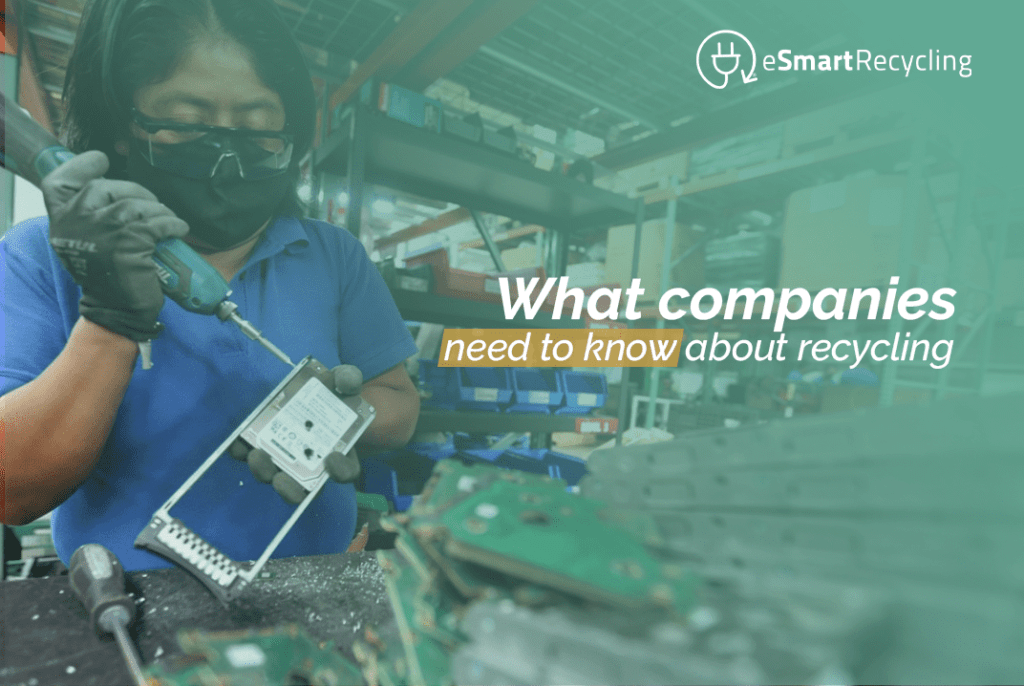
Recycling is an essential practice for both companies and individuals. In today’s world, it’s more important than ever to think about sustainability and how to care for our environment. Many companies are realizing the advantages of recycling materials sustainably, which can benefit them with substantial cost savings and help them achieve their environmental impact goals.
Companies must be aware of several critical concepts regarding recycling. They should research the materials they need to recycle and how they can be effectively recycled. In addition, they should look for tools, resources, and best practices to achieve the success they seek with their recycling efforts.
Companies must understand the types of materials they generate during their operations to develop an effective recycling strategy. Common materials companies generate are electronic waste, paper waste, plastics, and metals. Once a company knows the materials it generates, it can assess how easy it will be to recycle the different types of waste.
Companies should look for materials that are easy to recycle and require special handling. Particular substances take longer to process and dispose of, which can increase the costs associated with the recycling process. Check which materials can be locally recycled to reduce the impact of long-distance transport and recycling costs.
Companies that recycle obtain many potential benefits. They will not only help the environment, but they can also see how potential cost savings and opportunities arise due to being more sustainable.
Recycling can reduce the material a company needs to buy, saving it money. In addition, recycling can offer opportunities for the development of new products.
Companies should also understand how their customers and partners will see the company. Generally, companies that make significant recycling efforts are better regarded than those that do not take responsibility for their environmental impact.
Companies should spend time developing and executing a solid recycling strategy to get the most out of their recycling efforts. The plan should address how the company will be able to collect, process, and effectively dispose of materials in a way that meets its business objectives.
Companies can start by getting to know their area’s recycling options and resources. This can include wholesalers of recycled materials and local recycling centers. With a good understanding of the recycling options in their area, companies can work to develop a relationship with these partners and ensure their recycling efforts are managed in the right way.
Finally, companies should regularly review their recycling results to improve their recycling strategy continuously. Companies can track the amount of waste they generate and the type of materials they generate. This information can help them better understand their impact on the environment and how they can make further adjustments to their recycling strategy.
Companies can also work with recycling partners to learn how to improve their recycling efforts. Some recycling partners can help automate some aspects of recycling efforts or establish a team member in their office to take care of all recycling.
Companies should spend time understanding the materials they generate and their recycling efforts’ impact on the environment. Once the company understands the issue well, it can develop an effective recycling strategy to help it achieve its goals. By regularly reviewing their results, companies can improve their recycling strategies to continue being environmentally friendly and reap the benefits of sustainable recycling efforts.
Fill out the form below to request your electronics recycling pickup.
We’ll coordinate the schedule logistics and follow up with next steps.
Electronic waste —or e-waste— is piling up at an alarming rate, with consequences comparable (and in some ways worse) than those of plastic. For companies in the U.S. committed to sustainability, understanding this issue is no longer optional: it has operational, legal, and reputational implications.
In 2022, the world generated around 62 million tons of electronic waste, a figure projected to reach 82 million by 2030.
Only about 22 % of that amount was formally collected and recycled.
Just like plastic decades ago, e-waste often ends up hidden in storage rooms or landfills, quietly building up. Ignoring it might seem harmless —until it isn’t.
E-waste follows the same pattern as plastic did: short product lifespans, multiple devices per person, and products that are hard to repair.
Companies constantly upgrade equipment, but very few plan for what happens after.
Electronics contain heavy metals like lead, mercury, and cadmium, along with brominated flame retardants. When dumped or processed informally, these elements contaminate soil, air, and water.
Like plastic, e-waste doesn’t just disappear —it lingers.
Inside those discarded devices lie valuable materials: gold, silver, copper, and rare earth elements. Every ton of e-waste left unprocessed means losing resources that could feed back into supply chains.
Treating e-waste as “the new plastic” means recognizing that what looks like trash may still hold significant value.
If your organization upgrades laptops, desktops, printers, routers, or cables, how you manage the old ones should be part of your sustainability plan.
With us at eSmart Recycling, we handle secure data destruction compliant with HIPAA, provide detailed inventory audits, and reinvest around 30 % of proceeds into repairing and donating devices to underserved communities.
Improper e-waste management can also create legal risks —while there’s no single federal law, most U.S. states have regulations covering electronics disposal.
Done right, it’s more than compliance: it builds credibility and trust with customers and partners.
Because e-waste has become what plastic was decades ago: cheap, convenient, and everywhere. It’s piling up fast, and only a small fraction gets recycled. The difference is that this time, we can act before it’s too late.
At eSmart Recycling, we believe in giving technology a second life —protecting the environment while connecting people who need access the most.
New regulations are coming, and if your business handles tech equipment, you’ll want to be ready. At eSmart Recycling, we collect and recycle corporate technology responsibly—helping companies meet compliance without stress.
The U.S. still doesn’t have one single federal law for electronic waste. Instead, more states are passing Extended Producer Responsibility (EPR) laws, which require companies to manage the full life cycle of their products.
The EPA is also developing a national EPR framework for batteries, signaling tighter oversight of tech and electronic waste by 2026.
In short, if your business owns, sells, or disposes of IT equipment, you’ll need to:
Different states, different rules.
If your company operates across several locations, map out where e-waste and packaging EPR laws are already active.
Also, check which devices contain sensitive data—because disposal without secure erasure can violate privacy laws such as HIPAA.
That means:
That’s what we do at eSmart Recycling. We handle every stage—from pickup to final reporting—so your compliance paperwork is covered, and your data stays protected.
Saying “we recycle” isn’t enough anymore. Regulators and clients want evidence.
Include your e-waste and recycling stats in ESG or sustainability reports.
Work only with certified tech recyclers (like us).
And document your data destruction and donation processes to show that devices truly reached a responsible end.
Many state EPR laws will start requiring producer registration and reporting by 2026.
Being compliant early doesn’t just protect you—it gives you a competitive edge. You’ll be able to say: we’re already ready for 2026.
At eSmart Recycling, we collect and recycle corporate tech, audit every device, securely erase data, and donate refurbished equipment to communities that need it most.
Preparing for 2026 starts with doing things right today.
When a company decides to recycle its technology with us, two things matter most: keeping data secure and giving devices a second life. At eSmart Recycling, we make both happen, and we make it easy.
The first step is simple: schedule your pickup. You can do it directly at esmartrecycling.com or by emailing info@esmartrecycling.com. Our team will coordinate the best date and time for your organization.
If you’re in Tampa Bay, you can also drop off your equipment for free at one of our Community Collection Partners — local businesses and nonprofits that help us collect technology safely across the city.
Our team arrives with everything needed to handle your equipment safely. Every batch is tagged and recorded with a unique tracking number. That traceability follows the R2v3 and NAID standards, ensuring responsible processing and strict data separation (SERI, 2024).
Once the equipment arrives at our Tampa facility, we conduct a full audit of all devices. Anything that stores data goes through a certified destruction process that meets HIPAA and NIST 800-88 standards used in U.S. healthcare and financial institutions (NIST.gov).
Nothing is “partially wiped.” Every hard drive receives a digital certificate of destruction — so you know exactly what was done and when.
Not everything gets destroyed. A significant portion of the equipment can be repaired and reused. Our technicians clean, test, and refurbish those devices, preparing them for community programs that donate computers to children and families without access to technology.
As of 2025, we’ve delivered over 3,000 refurbished devices, reaching schools and communities both locally and abroad.
For items that can’t be repaired, our team dismantles them piece by piece. Each component — metals, cables, plastics, and screens — is sent to certified recyclers within the U.S., ensuring that materials re-enter the production cycle correctly and safely, avoiding illegal exports or environmental contamination (EPA, 2024).
At the end of the process, your company receives a complete report including:
This report helps you meet compliance requirements while demonstrating a genuine commitment to sustainability.
Recycling your technology with us isn’t just a task — it’s a practical way to protect the environment, keep your data safe, and create social value.
And it all starts with one click: schedule your pickup today.
When a company takes tech recycling seriously, it strengthens its reputation among clients, partners, and investors. A well-executed recycling program shows that the organization cares about environmental responsibility, data security, and social contribution. At eSmart Recycling, we collect electronic equipment—computers, laptops, printers, routers, cables—safely audit and destroy data, assess and refurbish devices, and donate part of them to communities in need. Here’s how that directly supports your corporate reputation.
Technology devices often store sensitive information. Poor disposal can lead to data breaches, fines, or brand crises. According to GreenCitizen, “responsible computer recycling… supports resource recovery, ensures compliance, protects data … and strengthens stakeholder trust.”
Similarly, E-Waste Solutions USA notes that “a proactive approach to e-waste management … contributes to … brand reputation.”
When clients or investors evaluate your business, they look at how you manage obsolete technology. If you do it with a certified partner that guarantees traceability, it builds credibility and trust.
Research on corporate electronics recycling shows that “a strong commitment to CSR, including responsible electronics recycling, can also help organizations attract and retain talented employees who are passionate.”
In a market where sustainability drives decisions, having a visible tech recycling program becomes a key differentiator.
The North American e-waste management market is expected to reach USD 33.33 billion by 2025. This means growing pressure for compliance and transparency.
By managing your obsolete tech correctly, you can document custody chains, certifications, and measurable results—making your ESG reports stronger and more credible.
At eSmart Recycling, we collect tech from individuals, companies, and institutions; audit, inventory, and securely destroy data under standards like HIPAA; assess and refurbish equipment; allocate about 30 % of our revenue to repairing and donating devices; and issue destruction certificates and environmental/social reports.
For your company, that means:
For sustainability leaders in the U.S., responsible tech recycling isn’t just a compliance step—it’s a statement of credibility and care that reinforces what your brand stands for.
When your company needs to recycle tech equipment, the most important thing is to work with a partner that’s certified, transparent, and safe. Here’s how to choose the right one — and how we do it at eSmart Recycling.
A solid indication that a recycling company does things right is certification under standards such as R2 or e-Stewards. The U.S. Environmental Protection Agency (EPA) recommends working only with recyclers certified under one of these programs.
When evaluating a partner, make sure they’re certified under R2 or e-Stewards and that their certification is current and verifiable.
To confirm you’re dealing with a legitimate, responsible recycler, here are questions worth asking:
A recycler that lacks proper certifications or processes can expose you to serious risks — from data leaks to regulatory fines or reputational damage. Data breaches cost companies millions of dollars each year.
Choosing the right partner also ensures that your retired equipment doesn’t end up in unregulated landfills or shipped overseas under unsafe conditions. Instead, it can be refurbished and placed back into use — supporting schools, nonprofits, and families who need it most.
We collect technology from individuals, businesses, and institutions — computers, laptops, printers, routers, and cables. Every item is audited, inventoried, and wiped clean according to strict standards like HIPAA, when applicable. Approximately 30% of our revenue is allocated toward refurbishing and donating devices to underserved communities in the U.S. and abroad.
We provide full documentation — from certificates of data destruction to environmental and social reports — so our partners know exactly what happened to every device.
If you’re in the U.S. and looking for a certified electronics recycling partner that’s serious about both security and people, that’s what we do.
Choose a partner with R2 or e-Stewards certification, secure data destruction, transparent processes, and proper documentation. That way, your company’s retired technology is handled responsibly — and if you’d like to add a social purpose to that process, we’d be glad to help.
Turning your IT policy into a sustainability policy means taking a full look at your technology lifecycle —from acquisition and usage to renewal and final disposition. At eSmart Recycling, we help companies and institutions take that step: we collect IT equipment, securely destroy data, revalue devices, and, when possible, give them a second life in community programs that need them most. Here’s how you can make it part of your corporate strategy, too.
Most organizations treat their IT policy as a technical document about hardware, software, and security—without considering the environmental or social consequences of technology management.
But the numbers are clear: global e-waste is growing fast. The Global E-waste Monitor 2024 reports that 62 million metric tons of e-waste were generated in 2022, and only 22.3% was properly collected and recycled.
That means two things: a major risk (data leaks, toxic waste) and a major opportunity (resource recovery, transparency, corporate reputation). Updating your IT policy to include sustainability ensures that every device your company uses has a responsible end-of-life plan.
Start by knowing what you have —servers, laptops, monitors, printers, routers, and accessories. Then, define each device’s lifecycle: when it’s purchased, maintained, replaced, and retired. This allows you to reuse or repurpose equipment before discarding it.
When devices reach the end of their life, they must be audited and securely wiped in compliance with data protection standards such as HIPAA. That’s exactly what we do at eSmart Recycling: collection, inventory, and certified data destruction —with full documentation and peace of mind.
Not all old devices are waste. Many can be repaired or refurbished and redirected to educational or community initiatives. Around 30% of the recovered value from our recycling operations goes toward refurbishing and redistributing technology where it’s needed most. That’s what circular technology looks like.
For your IT policy to have real weight, it needs measurable results:
According to the Global E-waste Monitor 2024, only about 22% of global e-waste is properly recycled —a number your organization can help improve by tracking progress and setting annual sustainability targets.
Sending your devices to a random recycler is not enough. The U.S. Environmental Protection Agency (EPA) recommends working only with certified electronics recyclers who can ensure traceability, responsible handling, and material recovery.
At eSmart Recycling, we’re certified under R2v3, the industry’s leading standard for responsible electronics recycling, data destruction, and traceability.
Let’s say your IT department retires laptops every four years. Under a sustainable IT policy:
That’s not just policy —that’s responsible technology management in action.
We handle every step of the process —from secure pickup and certified data destruction to reuse programs and measurable environmental results. Whether you’re a small business or a large corporation, we help turn your IT operations into a sustainability asset.
If your company is ready to upgrade its IT policy responsibly, contact us today, and let’s make it happen together.







If you want to know more about the different programs, partners, and overall cool things happening in the eSmart world, share your email with us, and Join the E-Revolution.